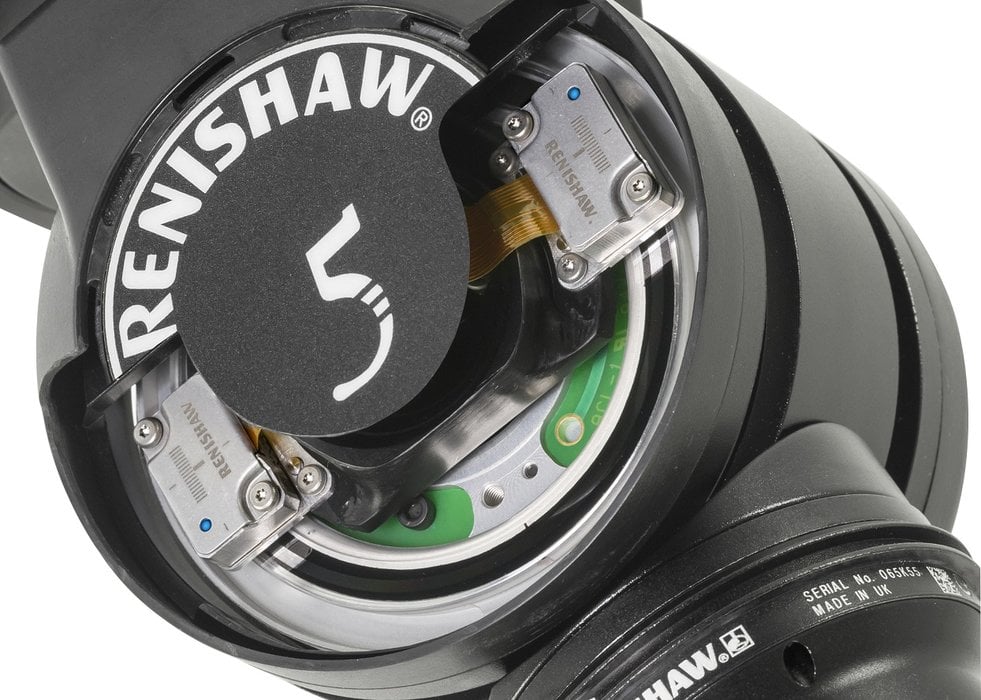Application note: Miniaturising innovation in the encoder business with the ATOM™ encoder
Shrinking the incremental encoder.

Modern high volume production processes, such as semiconductor manufacturing, demand production-line machines with ever smaller footprints to maximise productivity while also continually improving accuracy and throughput. This results in growing demand for smaller and lighter position sensors.
These position sensors, often referred to as encoders, comprise a readhead (an optical movement sensor) paired with a scale (an accurately marked ruler): the readhead measures position by optically sensing the regularly-spaced scale markings. A smaller readhead allows installation in tight spaces and a lower mass also reduces inertia to enable higher accelerations of the moving parts of the machine.
The ATOM miniature optical encoder was launched in 2014 and is Renishaw's smallest incremental encoder product: It remains one of the most compact optical encoder solutions on the market.
The ATOM incremental encoder is the only miniature encoder to use Renishaw's unique optics engine with patented filtering technology which imparts several advantages when compared with other types of miniature encoder including: better dirt immunity, lower cyclic error (improved accuracy) and higher resolution.
One of the greatest technical challenges in the design of the ATOM readhead was shrinking the optics of pre-existing compact encoders, such as the TONiC™ series of incremental encoders: an ATOM readhead occupies less than half the volume of a TONiC readhead.
Advanced manufacturing
ATOM readheads are too small to easily build by hand and so it is the first Renishaw readhead to be assembled with an automated process which also decreases process variability, leading to lower production costs and more consistent product quality. An automated assembly process provides significant flexibility of capacity that allows the rate of production to be readily increased from low to high. Multiple readheads can pass through the assembly process simultaneously.
The ATOM readhead is designed such that fine alignment and assembly operations are performed from one side of the product only and robot arms are used for component / sub-assembly transfer between each process stage. This is a largely unmanned assembly system with no human observers, so continuous process checking is essential.
All parts must first be correctly orientated by means of bowl-feeders and shaped feed-chutes. Automatic part identification is achieved by various means such as RFID (Radio-Frequency Identification) tags and advanced image processing techniques.
Furthermore, a Renishaw TP20 touch-trigger probe is used to calibrate the scale and readhead body datum positions during the assembly process. Correct alignment of the optical components within the readhead is achieved by a combination of optical checking and output feedback from the encoder sensor itself.
One of the first commercial applications of the ATOM encoder was in a new metrology product developed at Renishaw. The REVO® multi-sensor system is one of Renishaw's flagship products and enables users to perform 5-axis measurement on a 3-axis co-ordinate measuring machine (CMM).
It measures 1000s of points per second and operates at speeds up to 500 mm/s. As the head is much lighter and more dynamic than the CMM, it can quickly follow changes in the part geometry without introducing harmful dynamic errors.
REVO-2 builds upon the successful REVO multi-sensor system with enhanced power and communications capability to carry the latest REVO sensors such as the RVP vision measurement probe.
The original REVO product featured a custom-designed encoder with a fine pitch 12 μm phase scale developed before highly accurate miniature encoders had been brought to market. REVO-2 incorporates Renishaw's latest ATOM incremental rotary encoder with RCDM rotary (angle) glass scales on both of its axes (yaw and pitch).
It was the first product to have the ATOM encoder designed-in at the concept stage. Each 20 μm-pitch RCDM glass disc (Ø68 mm) is face-read by a dual-readhead setup which helps to optimise REVO-2 performance by eliminating rotational eccentricity error.
In this application, ATOM offers leading-edge accuracy and speed that enable excellent servo-loop gain levels for outstanding position holding and accurate surface scanning of parts / components. The ATOM system was also chosen for several design features including:
- Its mechanical simplicity and optical disc alignment method using a microscope camera system for improved installed accuracy.
- Ease of setup in conjunction with REVO-2's electronics allowing both incremental signal calibration and auto-phasing of reference marks without oscilloscopes or external equipment.
- Availability of chrome-on-glass rotary scale, with highly accurate scale markings, which enables REVO-2 to achieve a resolution of 0.002 arc seconds, delivering high precision over the full operating temperature range.
Richard Toller, Technical Manager for Renishaw's CMM Products Division, explains: “The ATOM encoder provides a level of plug-and-play convenience that simply didn't exist before. The ease of installation and alignment coupled with excellent technical support allowed the REVO-2 design team to fully meet the design specification while reducing overall production cycle time.”
To summarise, the ATOM encoder helps to streamline the REVO-2 manufacturing process, while still providing exceptional metrology performance. ATOM series encoders are designed to support manufacturing and servicing operations with streamlined installation and robust calibration procedures, in addition to Renishaw's unrivalled technical support.
The effects on the REVO-2 production process are reduced process cycle times, higher unit yields, greater efficiency and lower production costs.
www.renishaw.com

